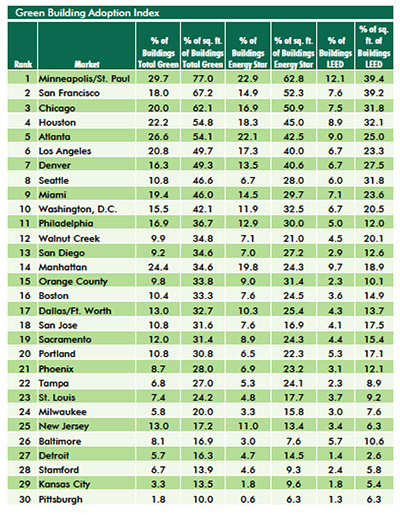LOS ANGELES — The 2014 Green Building Adoption Index, a joint project between CBRE Group Inc. (NYSE: CBG) and Maastricht University, has named Minneapolis as the greenest city in the nation, with 77 percent of the city’s commercial real estate certified as green. The term green is in reference to buildings that are either certified by the EPA’s Energy Star rating or the U.S. Green Building Council’s LEED program.
Rounding out the top 10 green cities are:
2. San Francisco (67.2 percent)
3. Chicago (62.1 percent)
4. Houston (54.8 percent)
5. Atlanta (54.1 percent)
6. Los Angeles (49.7 percent)
7. Denver (49.3 percent)
8. Seattle (46.6 percent)
9. Miami (46 percent)
10. Washington, D.C. (42.4 percent)
The study also emphasizes the dramatic increase in the number of green commercial real estate properties in the United States since 2005. During that time frame, the amount of Energy Star-labeled buildings has increased 600 percent, and the proportion of buildings that are LEED certified has jumped up 1,000 percent. LEED-certified space now totals 19.4 percent of the total building stock in the 30 office markets reviewed in the study when measured by floor area.
The study is the first project in CBRE’s Real Green Research Challenge (RGRC), the company’s $1 million initiative for research and innovation in sustainability. CBRE launched the RGRC in September 2012.

“We have all seen the rapid growth in the number of green-certified buildings in the markets in which we work. However, we were quite surprised to see how large the numbers actually are. Green is absolutely the new norm,” says Dave Pogue, global director of corporate responsibility for CBRE. “We wanted to do something in the built environment to help advance the discussion of sustainability. With the RGRC, we have the opportunity to affect the entire real estate industry and have a lasting effect on the way real estate is built, occupied and financed, and in doing so be a force for positive environmental change.”
Dr. Nils Kok of Maastrict University of the Netherlands leads the Green Adoption Index and works in close collaboration with CBRE and the USGBC. The study reviews more than 34,000 buildings — totaling more than 3.5 billion square feet — in the central business districts (CBDs) of the top 30 U.S. markets, in terms of square footage.
“This is the first study to quantify the relevance of green building practices in the commercial real estate market,” says Dr. Kok, associate professor in finance and real estate at Maastricht University. “While we all know examples of LEED-certified buildings, the results presented here are facts based on robust methodology, not anecdotal evidence. The evidence shows that green has become mainstream in all major U.S. cities.”
— Staff reports


